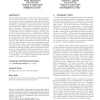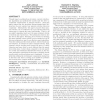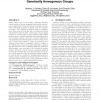GECCO
2010
Springer
14 years 4 months ago
2010
Springer
HyperNEAT represents a class of neuroevolutionary algorithms that captures some of the power of natural development with a ionally efficient high-level abstraction of development....
GECCO
2010
Springer
14 years 4 months ago
2010
Springer
An important goal for the generative and developmental systems (GDS) community is to show that GDS approaches can compete with more mainstream approaches in machine learning (ML)....
GECCO
2010
Springer
14 years 4 months ago
2010
Springer
Abstract. We discuss the problem of model selection in Genetic Programming using the framework provided by Statistical Learning Theory, i.e. Vapnik-Chervonenkis theory (VC). We pre...
GECCO
2010
Springer
14 years 4 months ago
2010
Springer
In order to allow a comparison of (otherwise incomparable) sets, many evolutionary multiobjective optimizers use indicator functions to guide the search and to evaluate the perfor...
GECCO
2010
Springer
14 years 4 months ago
2010
Springer
This paper describes a study of the evolution of distributed behavior, specifically the control of agents in a mobile ad hoc network, using neuroevolution. In neuroevolution, a p...
GECCO
2010
Springer
14 years 4 months ago
2010
Springer
GECCO
2010
Springer
14 years 4 months ago
2010
Springer
Crowding is a technique used in genetic algorithms to preserve diversity in the population and to prevent premature convergence to local optima. It consists of pairing each offsp...
GECCO
2010
Springer
14 years 4 months ago
2010
Springer
Evolutionary methods have been used to repair programs automatically, with promising results. However, the fitness function used to achieve these results was based on a few simpl...
GECCO
2010
Springer
14 years 4 months ago
2010
Springer
The family of natural evolution strategies (NES) offers a principled approach to real-valued evolutionary optimization by following the natural gradient of the expected fitness....
GECCO
2010
Springer
14 years 4 months ago
2010
Springer
Within nature, the success of many organisms, including certain species of insects, mammals, slime molds, and bacteria, is attributed to their performance of division of labor, wh...



